
How Do Chia Seeds Differ from Other Seeds?
, by sandhya ejji, 1 min reading time

, by sandhya ejji, 1 min reading time
Chia seeds, derived from the Salvia hispanica plant, are distinct from other seeds like flaxseeds and sesame seeds in several ways. They are rich in omega-3 fatty acids, fiber, and protein, offering a complete amino acid profile.
Chia seeds from the Salvia hispanica plant, are small, oval-shaped seeds available in black, white, or brown. In comparison, flaxseeds are elongated and come in brown or golden varieties, while sesame seeds are small, flat, and can be white, black, or tan. Chia seeds stand out for their rich nutritional content, gel-forming ability, and long shelf life, setting them apart from other common seeds.
Nutritional Composition:
Chia seeds are rich in omega-3 fatty acids, particularly alpha-linolenic acid (ALA), surpassing flaxseeds in concentration. They also contain more soluble fiber, which forms a gel-like consistency when soaked in liquid, aiding digestion and providing bulk. Chia seeds offer a complete protein profile with all nine essential amino acids, unlike other seeds like pumpkin and sunflower seeds.
Gel-Forming Ability:
Chia seeds can absorb up to 12 times their weight in liquid, forming a gel. This property allows them to thicken dishes such as puddings, jams, and smoothies more efficiently than flaxseeds, which require more time to develop a similar consistency.
Flavor Profile and Culinary Uses:
Chia seeds have a mild, neutral flavor, making them versatile in both sweet and savory dishes. Their culinary uses include being a thickening agent for soups and stews and a vegan egg substitute in baking. They are also commonly used in energy bars and snacks, providing texture and nutrition.
Shelf Life and Storage:
Chia seeds last up to five years when stored in a cool, dark place, outlasting flaxseeds, which are prone to rancidity due to higher oil content.
Conclusion
Chia seeds differ from other seeds in various ways, including their source, nutritional composition, gel-forming ability, flavor profile, culinary applications, and shelf life. Their unique properties make them a versatile ingredient in cooking and baking, allowing for creativity in the kitchen. Understanding these differences can help cooks make informed decisions when selecting seeds for their recipes, ensuring they choose the right ingredient for their culinary needs.